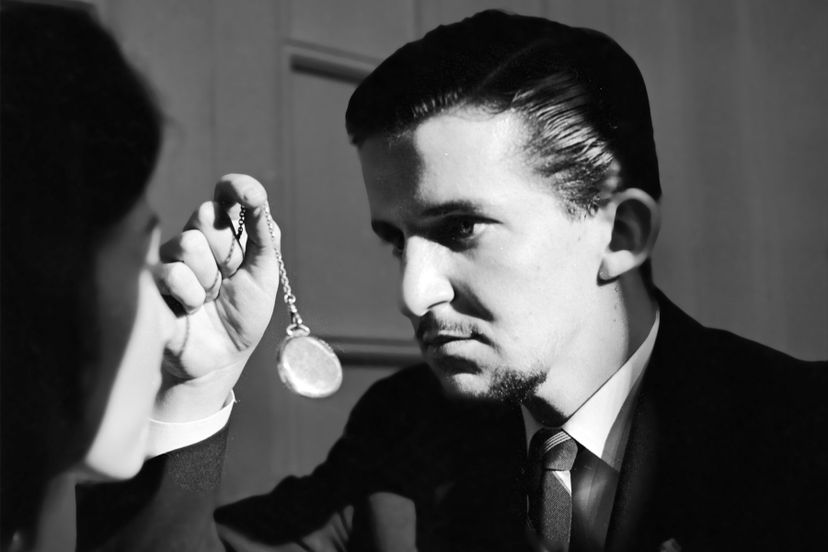
About This Quiz
You are getting very, very sleepy as you listen to the sound of my voice. How much do you know about hypnosis?When a person is hypnotized, she is relaxed ... but in a mental state that allows her to be much more open to suggestion from the hypnotist.
If you find yourself becoming very, very sleepy, maybe it's because the term originated from a Greek word that refers to sleep.
Contrary to popular misconception, people who are hypnotized aren't puppets or zombies -- they are in full control of their actions.
Advertisement
Many therapists believe that positive suggestions made during hypnosis can influence a subject's thoughts and behaviors following the hypnosis session.
With hypnotherapy, a therapist hypnotizes a patient and uses suggestion in the hopes of creating lasting positive emotional and mental effects.
The word mentalist is typically used to describe performance artists who may conjure all sorts of abilities, from divination, to mind control, to hypnosis.
Advertisement
In the late 1800s, researchers like Sigmund Freud began to see hypnosis as a way to connect a person with the unconscious mind.
The term neuro-hypnotism had already been in use by the middle of the 19th century. Braid helped shorten it to simply hypnotism.
He named the three stages "sub-hypnotic," "full hypnotic" and "hypnotic coma."
Advertisement
Stage hypnotism is performance art that accentuates a subject's willingness to act in front of others. Clinical hypnotism takes a more rigorous and scientific approach to this craft.
Hypnotic induction is any process that the practitioner uses to create a sense of hypnosis in the subject. Often, visual aids are used for induction.
These particular psychologists viewed hypnosis through the lens of role theory, and they saw hypnosis as a type of role playing.
Advertisement
Because they come with chains that make them easy to swing back and forth -- and are visually entrancing -- pocket watches are the stereotypical tool of the hypnotist. But any visually arresting object will do the trick.
Not everyone is susceptible to hypnosis. Some people don't react openly to the idea of suggestibility, making it nearly impossible for the hypnotist to put the subject under his spell.
The so-called Stanford Scale is made up of various tasks that test a subject's cognitive and motor skills. The idea is to rate just how susceptible a particular person is to hypnosis.
Advertisement
A subject that responds to suggestions is probably hypnotized … or at least pretending to be hypnotized.
Hypnotists often use visual tools to create the hypnotic trance in their subjects. A slowly swinging object, for example, causes people to fixate with their eyes and then slowly become hypnotized.
An Austrian doctor named Franz Mesmer conceived many of our ideas of hypnosis. He was mocked, however, for saying that hypnosis involved a flow of magical energy transferred from the hypnotist to the subject.
Advertisement
Hypnotherapy isn't magic -- the process uses mental conditioning to help patients improve their behaviors for the betterment of their lives.
In this particular profile, if a person's eyes roll back into his or her head, hypnosis is successful. The more the whites of the eyes are showing, the better.
The so-called placebo effect relies on simulated medical treatments. In many cases, patients who merely believe that a medication is working will show positive results. Hypnosis relies heavily on the placebo effect to generate its results.
Advertisement
People with active imaginations -- like those who have vivid recollections of imaginary playmates -- tend to be more susceptible to hypnosis than people who swerve more towards realism.
Hypnotherapy can not only help patients break bad habits, but it can assist people in addressing physical pain.
Any experience that causes you to be completely absorbed can be considered hypnotic. A boring book is more likely to make you feel distracted or restless.
Advertisement
Since the middle of the 20th century, many psychologists have viewed hypnosis as a helpful tool in restructuring the behaviors of their patients. Many people have reaped the benefits of this combined approach.
Braid noticed that there were many similarities between hypnosis and Eastern meditation practices, and he noted that they shared many of the same benefits, too.
One myth of hypnosis is that a subject might fall into a state of hypnosis and then never return to reality. Hypnosis might offer a temporary relief from reality, but it's not a permanent state.
Advertisement
At first, Freud was, shall we say, entranced by the idea of hypnosis. Eventually, though, he decided that psychoanalysis was a better way to address the human mind.
Franz Mesmer was so closely intertwined with hypnotism in the 1700s that hypnotism was often simply called "mesmerism."
Mesmer believed that hypnosis was a way to tap into the magnetic forces in the world all around us. These days, we understand that that power of the mind can help people learn and heal in many ways.
Advertisement